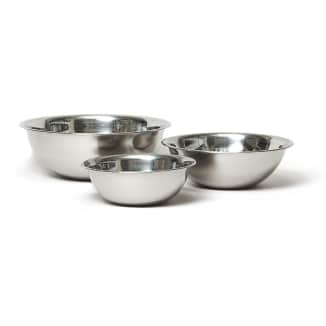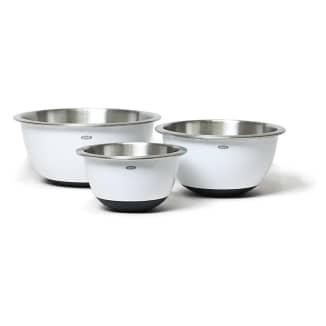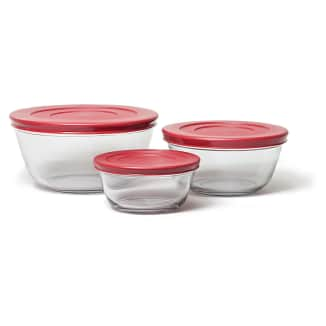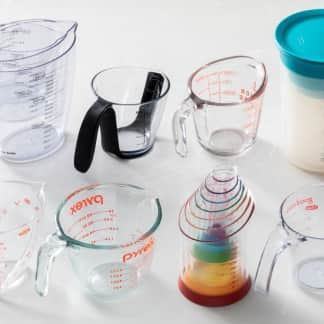They may not be as sexy as chef's knives or as cutting-edge as sous vide circulators, but when it comes to basic cooking tasks, plain old mixing bowls can't be beat. We reach for them any time we mix up pancake batter or vinaigrette, or when simply melting butter. A good bowl should be so steady, durable, and comfortable to handle that it goes almost unnoticed while you work.
For those reasons, we shop carefully when outfitting the test kitchen with mixing bowls. Our criteria start with size: At the very least, we need small, medium, and large bowls—by which we mean 1- to 1½-quart; 2½- to 3-quart; and 4- to 6-quart, respectively. We also find it useful to have a set in both stainless steel and glass: The lightness of metal makes it easy to use, but only glass can go in the microwave. Plastic and ceramic bowls just aren't practical: The former's porous surface scratches and retains oils, while the latter is so heavy that it's a detriment.
To single out a set of each, we scooped up three stainless-steel sets and four sets made of tempered glass (glass that has undergone a mechanical strengthening process to increase its impact and thermal resistance), all priced from $13.19 to $59.99. We bought nesting sets when possible and cobbled together a custom set if the sizes we wanted were available only as open stock. We then subjected the bowls to the core tasks that we think any mixing bowl should be able to handle. In each of the small bowls, we whisked oil into vinegar to make dressing. In the medium and large bowls we mixed up muffin and pancake batters. We also used the large bowls to mix bread dough and the medium bowls to melt chocolate in a jury-rigged double boiler, with the bowl set over a saucepan of simmering water.

Getting In Shape
Not all the bowls excelled at these basic functions. Some models even made easy work annoyingly difficult, thanks to a variety of design defects.
Take bowl height. A vessel's walls should neatly contain the food but be shallow enough that users—particularly shorter folks—don't have to strain to access the food. A side-by-side comparison of the 5-quart bowls from OXO and Vollrath illustrated this point: Standing nearly 5 inches tall, the OXO forced some testers to reach farther up and over its rim than felt comfortable, while the Vollrath, which was shorter by almost an inch, allowed easy access to the bowl's contents.
Vollrath, as well as Pyrex and Arc International, got the shape of the walls right, too. In relation to their bases, these bowls' sides curved gently, which made it comfortable for testers to not only reach into the bowls to stir but also hold the bowls aloft to pour and scrape ingredients out of them. Conversely, testers had to tilt bowls with steeper walls more dramatically if they wanted to scrape out every last bit of food, and once a bowl was nearly upside-down, it was awkward to maneuver a spatula around the inside. That's why some shorter testers found the relatively tall and narrow Cuisinart bowl set challenging to access, although, since those bowls were made of lightweight stainless steel, their shape was still manageable. The same couldn't be said for the Anchor Hocking glass bowls, a brutally heavy fleet with L-shaped walls and sharp corners that were hard to scrape clean. Testers observed that they looked more like storage containers than mixing bowls.

From Rim To Base
Whether a bowl had a rim also affected how comfortable—or not—it was to hold. The rimmed models, which included all the stainless-steel bowls as well as the Pyrex, offered roughly ¼ to ½ inch of grippable material. The alternative, the thickened collar that ringed the other glass bowls, was better than nothing, but not much. Grasping the 4-quart Anchor Hocking bowl, which weighed more than 3½ pounds empty, by its collar took some serious muscle. Its only perk: Its collar sloped smoothly down the inside of the bowl, whereas those on the Arc International and the Duralex bowls stuck out, trapping food in the crevices.
As for countertop stability, we used the vinaigrette test to determine how far each bowl moved as we vigorously whisked oil into the dressing. To our surprise, there were no clear advantages or disadvantages to using heavier glass or lighter-weight metal, nor to using bowls with broader or narrower base diameters. In fact, the bowl that traveled the farthest, from Anchor Hocking, was the heaviest and the broadest at its base. The only model that flat-out flunked the stability test was from OXO. Ironically, its supposed selling point—its rubber-coated base—was its downfall: Instead of keeping the bowl stable, the coating clung to the counter and caused the bowl to twirl to the point of tipping over. (The final blow to that set: OXO cautioned against using its bowl as part of a double boiler, since its exterior plastic coating could overheat.) In durability tests, one glass bowl cracked and another shattered, but all stainless bowls emerged unscathed.
Fortunately, the best models in both categories were also reasonably priced. The three from Vollrath's Economy Stainless line will set you back just $14.30 (at the time of this testing), while the Pyrex Smart Essentials set of four glass bowls (and lids) is as functional as it is affordable at $13.19 (at the time of this testing).
A Case For Both Metal And Glass
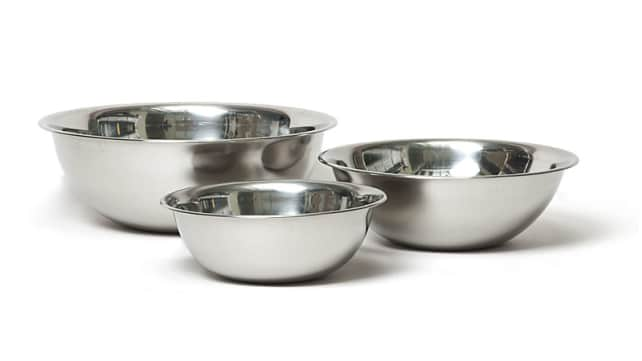
Why You Need It: Because lightweight stainless steel is so easy to handle and won't break, it's a default choice for most mixing tasks—particularly those for which a large bowl is needed, since metal will never get very heavy. Metal also conducts heat faster than glass, making it the better choice for a jury-rigged double boiler.
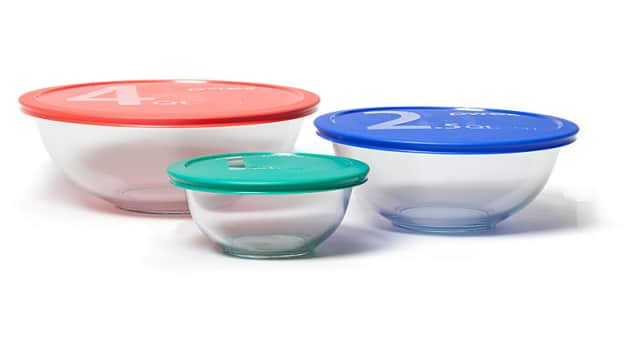
Why You Need It: Tempered glass is a must for the microwave. Its transparency also lets you check for pockets of unmixed ingredients. Good glass bowls can also be surprisingly durable; our winners from Pyrex resisted chipping when knocked against a Dutch oven and even survived an 18-inch drop onto the counter.

